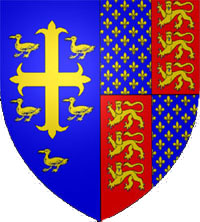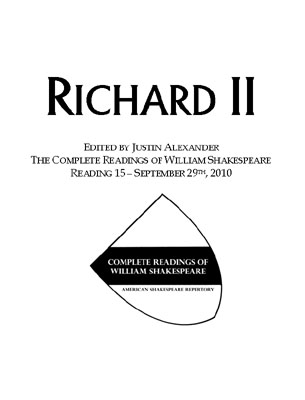 One of the interesting qualities of Elizabethan playwriting is the seamless connection between thought, word, and action. What makes the art of the soliloquy work, for example, is the lack of division between what the character is thinking and what the character is saying: They do not form their thoughts into words, but rather their thoughts leap directly to their tongues and into the ears of the audience. (Which is why Hamlet can advise his players, “Suit the action to the word, the word to the action.”) In a very real sense, the heightened reality of the verse essentially gifts the audience with telepathy: In watching Shakespeare, you are looking straight into the mind and soul of the character as it is stripped bare upon the stage.
One of the interesting qualities of Elizabethan playwriting is the seamless connection between thought, word, and action. What makes the art of the soliloquy work, for example, is the lack of division between what the character is thinking and what the character is saying: They do not form their thoughts into words, but rather their thoughts leap directly to their tongues and into the ears of the audience. (Which is why Hamlet can advise his players, “Suit the action to the word, the word to the action.”) In a very real sense, the heightened reality of the verse essentially gifts the audience with telepathy: In watching Shakespeare, you are looking straight into the mind and soul of the character as it is stripped bare upon the stage.
In a related fashion, Elizabethan plays often rely upon choric speech: Sequences in which the description of an action becomes the action itself as the words of the actor are transformed through the imaginative powers of the audience. In fact, such sequences can often be even more powerful than the action would be in a direct presentation. In Understanding Comics, Scott McCloud speaks of closure of as “the phenomenon of observing the parts and perceiving the whole”, and when a work of art demands of its audience that act of closure they become “silent accomplices”, “willing and conscious collaborators”. So, too, the Chorus of Henry V says:
Think when we talk of horses that you see them
Printing their proud hoofs in the receiving earth;
For ’tis your thoughts that now must deck our kings,
Carry them here and there, jumping o’er times,
Turning the accomplishment of many years
Into an hour-glass: For the which supply,
Admit me Chorus to this history.
It is a technique which turns a passive audience member into an active participant in the drama itself.
In the character of Richard II, Shakespeare weds the principles of the choric to the mold of the soliloquy in a series of transformative speeches which chart the fall of England’s king. It begins in Act III, Scene 3 as Richard speaks to Northumberland:
A’God’s name, let it go:
I’ll give my jewels for a set of beads:
My gorgeous palace for a hermitage:
My gay apparel for an almsman’s gown:
My figured goblets for a dish of wood:
My sceptre for a palmer’s walking staff:
My subjects for a pair of carved saints,
And my large kingdom for a little grave,
A little little grave, an obscure grave;
Or I’ll be buried in the King’s highway,
Some way of common trade, where subjects’ feet
May hourly trample on their sovereign’s head;
For on my heart they tread now whilst I live:
And buried once, why not upon my head?
The sequence of exchanges described by Richard are intensely choric in their nature: His description of those physical acts force the audience to “deck the king” (or, rather, undeck the king) as they specifically create for themselves the specific reality of those actions.
Of course, the actions in question are not real: They are, at best, a future possibility which Richard conjures up for both Northumberland and the audience of the play. But more than that, they are a metaphor for Richard’s shifting self-image. The change from Divine King to Holy Hermit is not merely a swap of costuming, but rather a fundamental change in Richard himself.
Which all sounds wonderfully abstract and soullessly intellectual, but here’s what the speech boils down to in practical effect: Physical transformation becomes a metaphor for mental transformation, and in the process the telepathic power of the soliloquy is coupled to the audience participation of the choric.
As an audience, we are not only gifted with an incredibly intimate vision of Richard’s thoughts, but we are also invited to participate in Richard’s process of transformation. Just as Richard himself is both the agent of his destruction and the victim of his destruction, we as witnesses are simultaneously both the agents and the victims of that destructive process.
THE CHORUS OF THE MOMENT
Shakespeare uses a similar and yet subtle variation of this technique in the next of Richard’s transformative speeches, which can be found during his deposition in Act IV, Scene 1:
Now, mark me how I will undo myself.
I give this heavy weight from off my head,
And this unwieldy sceptre from my hand,
The pride of Kingly sway from out my heart.
With mine own tears I wash away my balm,
With mine own hands I give away my crown,
With mine own tongue deny my sacred state,
With mine own breath release all duteous oaths;
All pomp and majesty I do forswear:
My manors, rents, revenues I forego;
My acts, decrees, and statutes I deny:
God pardon all oaths that are broke to me,
God keep all vows unbroke that swear to thee.
Make me, that nothing have, with nothing griev’d,
And thou with all pleas’d, that hast all achiev’d.
Long may’st thou live in Richard’s seat to sit,
And soon lie Richard in an earthly pit.
Here the elements of the soliloquy become muted, but they are not completely discarded: The physical actions of Richard undoing himself are still serving as metaphors for mental revelation, and thus the passage, like a soliloquy, is still a baring of Richard’s innermost thoughts.
What’s particularly fascinating here, however, is that the choric elements of the speech are amplified by their immediacy: Richard is performing the action in the very moment he’s describing it as the Chorus. And make no mistake, it is a Chorus: Because they’re metaphors, Richard is not literally performing any of the actions he’s describing. Which means that the audience is forced to create those actions in their mind’s eye.
Richard creates a ritual in which the rites and duties of his office are systematically stripped away. The process is both a transformation of identity and the loss of identity. But by invoking that intensely personal ritual in the form of physical metaphor, Richard forces his audience (both the audience of the play and the audience of nobles within the play) to become his partners in the act.
THE FINAL TRANSFORMATION
Which brings us to the last of Richard’s transformative speeches in Act V, Scene 5. (A speech which is also Richard’s only true soliloquy in the play.) The speech is long enough that I won’t quote it in full here, but its major framework looks like this:
I have been studying how I may compare
This prison where I live unto the world:
And for because the world is populous
And here is not a creature but myself,
I cannot do it: Yet I’ll hammer it out;
My brain I’ll prove the female to my soul,
My soul the father, and these two beget
A generation of still-breeding thoughts:
And these same thoughts people this little world,
In humors like the people of this world:
[…]
Thus play I in one person many people,
And none contented; sometimes am I King,
Then treasons make me wish myself a beggar,
And so I am: Then crushing penury
Persuades me I was better when a king,
Then am I king’d again, and by and by
Think that I am unking’d by Bullingbrooke,
And straight am nothing.
The same basic structure of self-transformation is pursued, but in an almost transcendant fashion: Richard transforms himself into the world, the world into himself, and ends himself in nothing. It culminates a sequence in which Shakespeare’s language literally transforms Richard before our eyes from one state of being to another. (And in a play with multiple references to caterpillars, no less.)
POWER AND IMPOTENCE
There is more to be found in this theme of transformation, however. The ability for power to enforce transformation is suggested heavily from the very beginning of the play (Act I, Scene 1):
RICHARD Rage must be withstood,
Give me his gage; Lions make Leopards tame.
MOWBRAY Yea but not change his spots: Take but my shame
And I resign my gage…
Mowbray may resist this change, but he is nevertheless forced to it.
There is a degree to which the play can be seen as an abstraction of the old query: Can God create a rock so large he cannot move it? Can the king’s power to force transformation be used to transform the king into something other than the king?
Viewed through this lens, Richard’s struggle to give up the crown is not merely the mortal struggle of a man who doesn’t want to give up his power; it is a literal struggle between potence and impotence. Richard says:
We thought ourself thy lawful King: (…)
If we be not, show us the Hand of God
That hath dismiss’d us from our stewardship.
Only the Hand of God can remove divinity from the King and thus remove the King from his right. But while the king himself can be said to act as the hand of God, if he tries to take that power from himself does he not take the very power which would let him take it?
BULLINGBROKE Are you contented to resign the crown?
RICHARD Aye, no; no, aye.
Shakespeare presents us with an immovable object and an unstoppable force; he forces Richard to face a crisis both human and divine. And then he gives to the actor both “aye, no” and “no, aye”: The opportunity to express both the mortal and immortal dimensions of the problem (or vice versa) in four simple syllables.
Originally posted on September 29th, 2010.












